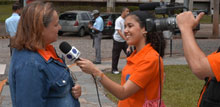Basic Teaching Techniques for Moving Images
The eight basic
techniques described on these pages are designed to
help you unravel the codes and conventions of the
moving image, and enable you to use a wider range
of film and video texts in the classroom. As you
and your pupils unpack the layers of meaning, you
will be helping them to develop their general
skills as more critical, attentive and
knowledgeable readers of the moving image.
Learning Objective
•
Most moving
image texts are produced within editorial
and institutional constraints: time,
budget, context, purpose etc.
• Content and form will vary according to audience and purpose.
• Addressing a different audience can add ethical or legal factors which will affect what can and
cannot be said or shown.
• A critical challenge to an existing text must have good evidence to back it up which can come from both within the text itself and from other sources.
• Alternatives are possible.
• Content and form will vary according to audience and purpose.
• Addressing a different audience can add ethical or legal factors which will affect what can and
cannot be said or shown.
• A critical challenge to an existing text must have good evidence to back it up which can come from both within the text itself and from other sources.
• Alternatives are possible.
Key Questions
• Why have
you chosen this age-group/audience?
• What in the existing text will not appeal to or be understood by its new audience?
• What aspects of the text can you use to sell it to its new audience?
• What methods would be most appropriate to reach that audience?
• From what point of view are you arguing against the text or for a different version?
• What evidence are you using to back up your argument?
• Who is the audience for the new version?
• What in the existing text will not appeal to or be understood by its new audience?
• What aspects of the text can you use to sell it to its new audience?
• What methods would be most appropriate to reach that audience?
• From what point of view are you arguing against the text or for a different version?
• What evidence are you using to back up your argument?
• Who is the audience for the new version?
Simulation
• Pairs or groups of pupils are placed in role as producers of an existing moving image text used in any subject curriculum and asked to produce plans for how they would• modify or reconstruct it for a different agegroup;
• ‘sell’ the text to a different audience;
• challenge it critically from a particular point of view;
• produce an alternative text.
The plans should be presented to the teacher or
another group acting as Commissioning Editor or
Executive Producer.
